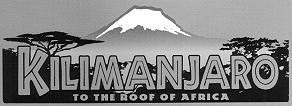| Thin Air (Large Format) | ||
| Kilimanjaro: To the Roof of Africa | ||
 |
||
| Review by Ross Anthony | ||
|
Classic migrational herd shots and a warm Tanzanian narrator rally attentions to a snow capped volcano at the equator, the highest peak of Africa, the highest freestanding mountain in the world. We are introduced to the small group of tourists set on making the climb to the peak: the geologist, the older writer, the Scandinavian tourist, the twelve-year-old American girl and a local boy. All ready to brave the 45-mile hike, 19k feet into the sky, through rocks, snow, and air thinner than thin air. Our narrator is their caring guide. The filmmakers follow this chatty group with inserted small screen interviews over the big screen vistas. We hear their personal comments, then a moment later the video is hemmed in - it's a warm editing touch. However, at times the climbers speak a bit stiff, and on an occasion or two, the video insertion lands flat over and obscuring the climbing action of the big picture. As the group nears the peak, they become less certain, less full of confidence and oxygen. An odd detour (in aerial footage) of the rift valley is the only inclusion to break this linear trek. After stumbling across elephant bones our narrator wonders, "What were these animals looking for? Why did they climb so high onto this mountain?" It's the first time my curiosity is peaked. Additionally, majestic glacier shots grace screen, but lack an answer to earlier longings of the young Tanzanian to see snow. (That said, you'll get a chuckle out of his subsequent "bath" longings.) Heavy on narrative, and short on big screen visuals and audios, "Kilimanjaro" makes a better TV documentary than Large Format experience. Additionally, some sort of visual introduction to Kilimanjaro by way of general description of African terrain, with a zeroing in on Tanzania, giving the viewer a feel for where the mountain is located with respect to the continent and perhaps some history would have helped. Such an intro would also have provided a better placement for the rift valley sequence. |
||
|
|
||
|
||
Grade..........................B- |
||
Copyright © 2001. Ross Anthony, currently based in Los Angeles, has scripted and shot documentaries, music videos, and shorts in 35 countries across North America, Europe, Africa and Asia. For more reviews visit: RossAnthony.com |
||
|




